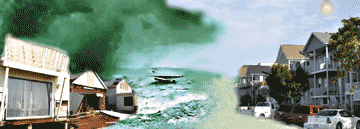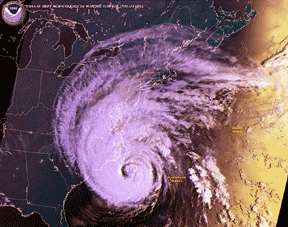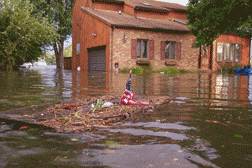 |
|||||||||||
|
|||||||||||
|
|||||||||||
ChangesFour Years After Isabel, Our Bayfront Has a New Look,
|
|||||||||||
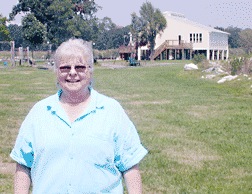 |
Joanne Groves woke the morning after Isabel to four-foot-deep water outside her home in Cedarhurst. Behind her is the new community center; the previous center, below, was totaled in the storm surge. |
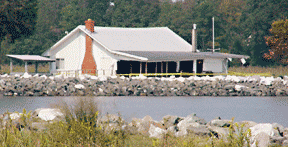 |
“I woke up at 4am,” recalls McAllister, “and got everyone out of bed. The water was lapping at the foundation.”
The generator he had purchased the week before was about to go under water. “We grabbed the generator and hauled it to higher ground,” he says. “I’m lucky I got to it in time. For a week after Isabel, I was the only one in Cedarhurst with power. Everyone lived at my house.”
The community center was damaged beyond repair. Boulders from the sea wall were scattered like pebbles. The community pier was destroyed and the marina flooded.
Of the 310 homes in the community, Groves estimates at least 80 percent were affected by the storm. Twenty-one homes were left uninhabitable.
What happened as Cedarhurst slept? Storm surge.
The storm-driven Bay rushed over parallel Chesapeake Avenue and pushed almost one-half mile up the village’s perpendicular streets as if they were canals.
Four years later, life in Cedarhurst is just getting back to normal. Only a few reminders of the damage remain by way of a couple of houses sitting empty, abandoned by owners without insurance or means to repair or rebuild them. The last FEMA trailer was hauled away in June. On almost every street of this close-knit community, there is the sound of pounding hammers and whirring saws as homes are repaired or rebuilt. The marina sparkles in the late summer sun, children fish from the rebuilt pier, and construction on the new community center — perched 10 feet above ground — was completed just this spring.
Today, for most Cedarhurst residents, Isabel is just an unpleasant memory.
North Beach’s Storm: The Slam
Fifteen miles south of Cedarhurst, it was a different Isabel that roared into town. In Calvert’s North Beach, violent eight- to 10-foot-high waves pummeled the waterfront. People who chose to stay with their homes had a long, sleepless night.
Town councilman Andrew ‘Bud’ Hunt remembers the noise. “It was a constant roar,” he says. “It is something I’ll never forget. There were rockfish rolling in the surf, stripped of their scales, it was so rough.”
As in Cedarhurst, morning light revealed the extent of the damage. Homes along the waterfront were battered, some beyond recognition. The boardwalk was in shambles and boulders from the sea wall lifted by the powerful surge sat in the middle of Seventh Street. In places water was chest deep.
“Citizens were in shock,” says Mayor Mike Bojokles, a city councilman at the time of the storm. “Everyone was wondering what to do, what now. One of the most frustrating things was the number of people who came to just stare. They were letting their kids wade through water that was full of debris and dangerous. It was a carnival atmosphere. If you didn’t live here, you thought it was fun.”
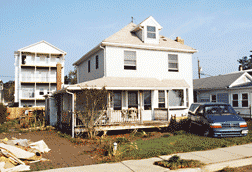 |
Richard Walsh sat out Isabel in his Bayfront home on Atlantic Avenue. The storm became so bad that even if he had wanted to evacuate, he couldn’t leave. Afterward, he raised the original 1930 house, above, on eight-foot concrete piers, below. |
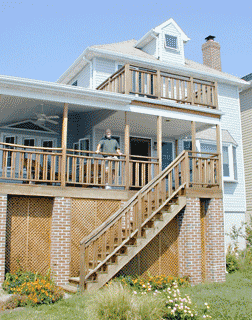 |
Richard Walsh sat out the storm in his Bayfront home on Atlantic Avenue. During the night, the storm became so bad that even if he had wanted to evacuate, he couldn’t leave.
“I remember the sound of the waves beating on the walls,” Walsh recalled. “When the surge hit, the water spray blew up over the house.”
He had his van parked in front of his house. “The storm surge lifted it up off the ground and tossed it toward my living room window. Luckily it got hung up in the mud. That stopped it from smashing into the room.”
Four years after Isabel left a foot of water inside the house, construction on his new house is finally complete. No longer at ground level, the house now stands on concrete piers — safe from harm’s way, he hopes.
“It’s the original 1930 house, but I had it lifted eight feet off the ground,” Walsh says. “Then I had to replace all of the flooring and drywall on the first floor.” A new second floor addition replaced the storm-battered ground-level porch. Walsh was lucky. His home could be repaired, and he had insurance to pay for it.
Walsh’s 83-year-old neighbor Jack Metee is building a new home to replace his family home. “He toyed with repairing it instead of tearing it down,” Walsh said. “But in the end, he decided to start over.” Without insurance, Metee, a tradesman, had the shell built. He and his family are doing the finish work themselves, a little at a time as finances permit.
Today North Beach bears little physical evidence of damage wrought by Isabel. The boardwalk has been repaired, the seawall and beach restored, and most of the damaged homes have been either repaired or rebuilt.
Atlantic Avenue, once lined by bungalows and little beach cottages, is now home to multi-story, million-dollar homes. In the few vacant lots on the north end of town, new homes and condominiums are advertised with big price tags. As a result, property values have soared.
“It’s a bit of a silver lining,” says now-mayor Bojokles. “The town’s tax base has certainly increased. But at a terrible cost to our community.”
For those residents who lived through Isabel, memories of that long night and the months of cleanup are still vivid reminders of Mother Nature’s fury.
Four years later, Bojokles stares out over the calm waters of the Bay. “Just imagine what a category two or three hurricane would do,” he says with a shudder.
The Isabel Investment
When the skies cleared and the water receded, FEMA estimated damage in Maryland to be close to $600 million dollars. On September 19, President George W. Bush declared the entire state of Maryland a disaster area, thus allowing citizens harmed by the storm to be eligible for federal aid.
Maryland residents had already received almost $100 million in disaster aid by December 1, 2003. Private insurance paid out an estimated $410 million dollars to Maryland policyholders. Four years later, a tour of Cedarhurst, North Beach or any other of those inundated communities — from Venice Beach in Pasadena to Cove Point in Calvert County — shows where all that money went.
Thanks to Isabel’s windfall, modest beach bungalows damaged beyond repair have been replaced by new multi-story homes, some so grand they include elevators. Many new homes tower above their original undamaged neighbors. Keeping up with their new neighbors, salvageable older homes have been upgraded to dreamy heights.
Two factors explain the stilty new highrises.
First, new houses all sit on piers at least eight feet above the ground to comply with flood-zone building codes. That’s eight feet of supposedly empty flood through-space, in which nothing is to be permanently affixed; pumps and heating and cooling systems are now strapped to high walls or perched on decks.
Second, on the small lots, beachfront communities’ expansion had no place else to go but up.
All that height has changed the face of the old neighborhoods. From small and squat, houses have gone to high and mighty. Exterior stairs rise to raised first floors and soaring upper stories. Brick-simulated concrete clads the understory; man-made siding sheaths the upper, replacing old-fashioned wood. Windows are wide, to capture Bay views. From cottages created over years of tight money and easy regulations, houses have risen overnight to cookie-cutter code.
Property values have soared along with the rooftops. Ed McAllister of Cedarhurst wondered if all the news coverage about flood-prone neighborhoods would hurt his property value. He needn’t worry.
“My property value has skyrocketed,” McAllister says. “With the repairs to my house, and
72-Hour Disaster Kit Contents• Portable, battery powered radio/TV and extra batteries • Flashlight and extra batteries • Non-portable, plug in phone • First aid kit and manual • Prescription medications • Credit cards/cash • Personal identification • Extra set of car keys • Map of area and phone number of places you could go • Special needs: diapers, formula, hearing aid batteries, etc. • One gallon water per person, per day • 3-day supply of non-perishable food: Canned foods-ready to eat meats, fruits and vegetables, peanut butter, nuts, granola bars, juice/drink boxes, bottled water, cereal, crackers. |
all of the work going on in the neighborhood, my house is worth more now than it was the day before Isabel.”
Preparing for the Next One
In both Anne Arundel and Calvert counties, emergency management offices say they are far better prepared for the next natural disaster.
“One of the biggest improvements is our use of geographical mapping system,” says Captain Tom Wilson, director of Anne Arundel Emergency Management office. “We rely on NOAA for forecasts, but now we are able to better identify specific geographic areas in the path of a storm and have a better idea what to expect from a storm surge and notify those particular areas earlier.”
Post-Isabel, Wilson’s Emergency Operations Center upgraded from low-tech to high-tech.
“We have more capability, more technology to coordinate first responders in the event of a disaster,” he explains. “Pre-Isabel, we were low-tech with just six telephone lines, a fax machine, TV and a white board with markers. Today we have 30-plus working phone lines and computers with specialized software.
“The new software enables us to immediately communicate our needs to MEMA [Maryland Emergency Management Agency] and the National Guard to get a much quicker response. We now pre-position National Guard trucks in areas expected to be hard hit.”
Following Isabel and Katrina, Calvert is working to expand citizen awareness. In all sorts of emergencies, it uses the Code RED emergency telephone notification system to get the word out.
“But if residents had portable phones instead of plug-in phones, they lost phone service when electric service was disrupted,” explains Sandy Simmons, emergency management specialist for Calvert County. Calvert’s post-Isabel preparedness campaign includes reminding citizens to have a plug-in phone as part of emergency preparedness kit.
Hotline numbers advising citizens on emergency actions are publicized on Comcast cable, EAS radio and their website.
Four years after Isabel, emergency planning remains a work in process. Just this month, Calvert figured out how to shelter pets in emergencies.
“We saw in Katrina that residents were not able to bring their pets with them and, as a result, did not take advantage of sheltering opportunity,” Simmons says. “Now, Calvert has established a pet-friendly shelter. Pets can be housed in the Career Center as the owners are sheltered at Calvert High School. Trained volunteers will care for the pets.”
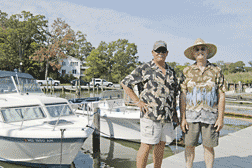 |
After all the rebuilding following Isabel, Ed McAlister, at left, has seen the property value of his Cedarhurst home skyrocket. |
How to remove debris after a hurricane or other natural disaster is another question both counties are now answering. Calvert has established a committee, and Anne Arundel wrote its plan based on its Isabel successes.
“During and after Isabel, there was so much sea grass blown in you couldn’t drive down roads. Boats had floated down streets,” says Bea Poulin, community specialist for Southern Anne Arundel County. “Public Works was quick to recognize what they needed to do. We identified a number of issues including how to get rid of debris quickly. We moved in front-end loaders and placed dumpsters where people could get to them.”
Cleanup costs were huge. The only tally was made by FEMA, which reimbursed Anne Arundel County an estimated $3.2 million dollars. Calvert received over $1.8 million.
Communities also need to plan ahead because they can be isolated by disasters.
“After Isabel, many Anne Arundel communities were cut off by floodwaters,” recalls Poulin. “First responders couldn’t immediately get to them. As a result, we are encouraging our waterfront communities to organize residents to be prepared. For example, a citizen’s emergency response team has been formed in Shady Side to help each other help ourselves until first responders arrive.”
Ed McAllister thinks his community of Cedarhurst got it right. “We all pulled together as a community and got to work. As soon as the water receded, we started to clean up. We didn’t wait for help.”
Are You Prepared?
Four years after the storm, it’s easy to forget that Chesapeake Country is vulnerable to these hurricanes and their powerful surges of storm water.
Some people in the affected communities left the waterfront. But most residents chose to stay put, believing Isabel was a 100-year storm and wouldn’t happen again in their lifetime.
As Cedarhurst’s residents picnicked, clouds from another tropical storm, Gabrielle, blew across the distant horizon. This storm turned out to sea. Will the next one follow the path of Gabrielle — or Isabel? It’s anybody’s guess. But it is a pretty safe bet that some day another storm of Isabel proportions — or worse — will strike. County governments are working to prepare for the inevitable. So should you.
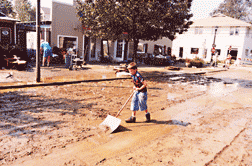 |
photo by Doug DeMarkA boy shovels North Beach’s main drag the day after Isabel. |
Know what your insurance policy covers and what it doesn’t — before you need to make a claim. Check your policy for adequate coverage; The cost of repairing or replacing your home has probably risen since the policy was written.
That’s a lesson one Shady Side family learned. Their insurance policy had not been reviewed or increased since they purchased the house 15 years earlier. After Isabel, they wanted to tear down their damaged house and rebuild a larger, modern home on the property. Insurance only paid enough to make the necessary basic repairs.
“Typical homeowners’ policies do not cover damage from the flooding that accompanies a hurricane,” explains Mike Barry of the Insurance Information Institute. “If you’re a homeowner in a flood zone, you need a flood insurance policy. The National Flood Insurance Policy is administered by FEMA, and the premium is subsidized by the federal government.” Find information through a local insurance agent or on the web at www.floodsmart.gov.
“Homeowners also need to be aware of hurricane deductibles on their policy,” Barry says. “These are usually five percent, which means on a $500,000 policy, homeowners would be responsible for the first $25,000.”
Cedarhurst resident McAllister learned his policy only covered outbuildings, like his garage, if they were connected to his home. Others learned their insurance only covered property that was completely destroyed or was a health hazard; if it could be repaired, it wasn’t covered by flood insurance.
After you check your insurance, collect your own 72-hour disaster kit.
The next big storm might not know the citizens of Chesapeake Country are banking on 96 years of grace.
To learn more
Anne Arundel County Office of Emergency Management: 410-222-0600; www.aacounty.org/OEM/index.cfm
Calvert County Office of Emergency Management: 410-535-1600, x 2638; www.co.cal.md.us/residents/safety/emergency
|
Current Issue \\ Archives \\ Subscriptions \\ Clasified Advertising \\ Display Advertising |

